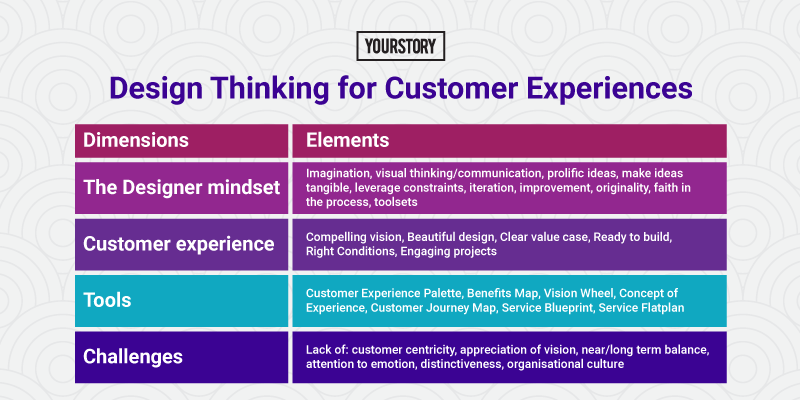Launched in 2012, YourStory's Book Review section features over 285 titles on creativity, innovation, entrepreneurship, and digital transformation. See also our related columns The Turning Point, Techie Tuesdays, and Storybites.
Much has been written about product design, but problem-solving approaches like design thinking can be applied to the service world as well. Besides, the line between product and service is blurring, and many business models blend the two.
Frameworks and tools for business excellence are well-explained in the book Customer-Driven Transformation: How Being Design-led Helps Companies Get the Right Services to Market, by Joe Heapy, Oliver King and James Samperi.
Joe Heapy and Oliver King are Co-founders of Engine Service Design, while James Samperi runs their Dubai-based programme of work. The book is a blend of academic research and business advice, based on the company’s 20 years of experience.
Here are my key takeaways from the 200-page book, summarised as well in the table below. See also my reviews of the related books Design Your Thinking, Deliver Great Products that Customers Love, Creative Thinking Handbook, and Innovator’s DNA.

I. Foundations
The authors begin by explaining how the discipline of design contributes to business through imagination, team effort, exploration, experimentation, and improvement. Effective service design helps conceptualise, develop, fix, or transform services.
Business success comes not just from brand expression but customer experience as well. Brand personality does play a role in identity, as seen in the case of Orange (‘bright future’), O2 (‘fresh air’) or Vodafone (‘corporate credibility) – but how customers perceive the service proposition is more important.
“What a brand says is marketing, what it does is its service proposition,” the authors emphasise.
Customer experience encompasses their entire journey – from search to disposal – but many companies confuse it to just post-sales customer service. Many companies are set up in silos, and lack of a unified view makes it hard to provide a unique and rewarding customer experience, the authors caution.
Elements of the Customer Experience Palette are service performance (eg. reliable, accurate), service usability (convenient, easy), customer service (empathetic, polite), emotional fulfilment (useful, enjoyable), brand presence (distinctive, aspirational), and product benefits (clear, valuable).
Effective customer experience design begins from the outside-in, not just from the inside-out or top-down. The book illustrates these principles through examples like Dubai Airports, E.On Energy, Hyundai, Finnair, UK National Grid, Pegasus Life, and Bupa. Effective product design is seen in companies like Apple and LEGO.
“Design thinking effectively provides a structure – a scaffold – that shapes the process of service development and guides teams to effective, beautiful and desirable service provision,” according to Andreas Tsiotsias, CTO, Computer Services Industry, IBM.
In the development journey, designers also help in storyboarding, prototypes, presentations, training materials, documentation, visual branding, touchpoints, and design of products and spaces. “Trust the design process,” the authors advise.
Market leaders use service design to create ‘magic’ that leads to customer delight as well as a competitive advantage and market differentiation. Examples include Netflix, Airbnb, and Uber.
"The design of the services we interact with each day is critical in the ever more competitive world of brands vying for our loyalty,” observes Deborah Dawton, CEO, Design Business Association, UK.
Hallmark moments or experiences make the brand stand out. Examples include Amazon’s one-click shopping, Virgin Atlantic’s icecream during movies, Metro Bank’s issue of a bank card within 15 minutes of opening an account, and NatWest Bank’s ATM cash withdrawal feature even for those who lost their bank card.
“Designing a better experience for when things go wrong can help reduce the negative impact on your customers and retain some of their goodwill as well,” the authors add. Mapping service failure and service recovery are key in this regard, to potentially convert a negative experience into a positive one.

II. Design-led customer experiences
A service vision describes a future state for the service and the customer, and helps create decision processes and steps to get there (“pragmatic aspiration”). The story should be easy to tell and re-tell, and should be updated every few years as contexts change.
“A compelling vision for your service gives your decision-making a strong purpose,” the authors describe. It is based on insights, and motivates, inspires and engages employees. Collectively building the vision can ensure organisation-wide buy-in and a sense of ownership.
Emotional elements of a good service can be described through terms like reliable, helpful, authentic, distinct, timely, thoughtful, elegant, and beautiful. These should be captured in design promises and principles. Customers will then become loyal, recommend the company, and even forgive it if it makes mistakes, the authors describe.
Beautiful design is more than just looks – it deepens emotional connection and respects detail. It is original, and inclusive of diverse audiences. It not just meets the brand expression, but exceeds customer expectations, the authors describe.
Design-led organisations empower contributors across the board, learn by doing (not just from data), and treat failures as sources of learning. They build a clear value case with a strong imperative and quantifiable benefits, and back it up with prototypes.
The authors make an important distinction between prototyping (early exploratory mock-ups) and pilots (live version of a service on a limited audience). Pilots happen later and can be more costly and risky.
The authors describe several planning tools and documents in this regard, called the Design Package. This includes the Experience Portfolio and Experience Roadmap. The Benefits Map should show the flow from tangible investment to customer benefit, customer outcome, business benefit, and vision fulfilment.
The Service Vision Wheel connects the central big idea to constituent principles and action steps via concentric circles. The Customer Journey Map represents the customer’s entire journey, while the Concept of Experience maps current and desired customer emotion curves.
For each customer journey step, the Service Blueprint lists physical and digital touchpoints, operational processes, and people. The Service Flatplan connects these to offers, enablers and capabilities.
Some of these steps may take longer to deliver, eg. integrating CRM and billing systems, which may require bringing partners and vendors on board. “Co-creation is king, so prepare for collaboration,” the authors urge.
Perseverance, prototyping, social proof, customer validation and open house sessions help sustain the momentum. This can be done through a series of engaging projects, for which individual stories and brands can be built. Factoring in diversity at early stages and senior managers at later stages helps delivery.
For example, E.ON’s principles include We’ll speak your language and make it simple and We’re the experts so you don’t have to be. PegasusLife built “experience showrooms” and “taster apartments” to give pensioners immersive experiences of assisted living properties.
Many food outlets now have ordering kiosks to reduce queue waiting times. Dubai Airport has eight cross-disciplinary ‘labs’ for cross-pollination of ideas and people, and commits to experimenting, prototyping and training.
Helsinki Airport leveraged design elements like ‘Nordic Wonder,’ and brought in natural landscaping as well as simplicity. Information services were designed to put passengers at ease with respect to travel schedules and airport navigation – and led to more satisfaction and store purchases.
Hyundai designed one of its retail centres as a cultural space to attract younger wealthy buyers. It showcased rare books about cars, and interactions with designers, engineers and racers.
III. Challenges in service design
The authors identify a number of challenges which come in the way of delivering outstanding customer experiences. By not having a customer orientation to begin with, companies end up delivering services customers may not need, or may miss out on ideas and collaboration from customers.
In an increasingly digital world, companies may end up without alignment of physical and online store experiences. Leaders may not commit to the time and effort it takes to understand customer concerns and align the company to address these issues – or they may be satisfied with good enough rather than outstanding customer experiences.
There is also confusion between terms like vision, mission, strategy and objectives. Near-term thinking gets in the way of setting long-term compelling visions, or understanding the emotive and driving power of a compelling vision.
Companies tend to focus too much on near-term service fixes for quick results, but not enough on long term transformation. Speed without direction is a problem, the authors caution. Changing a large service-based organisation takes time and patience.
Focusing only on the rational and transactional elements, and relying only on data, misses out on the contribution of emotion in service delivery and customer experience. Unfortunately, emotional elements can be hard to quantify or embed, the authors observe.
It’s one thing to deliver services in a consistent and natural manner, but another to be distinct and deliver surprises. Leaders often get stuck in their own internal myths and organisational bubbles, the authors caution. Cultural barriers to unified service delivery include lack of creativity, commitment, accountability, alignment, time and resources.
The road ahead
Even though technology coupled with behavioural economics has changed service delivery, the new battleground may be emotion, the authors observe. This applies to customers, employees and partners.
Effective service design requires a mix of generalists and specialists. “Today, generalism has become a prized specialism,” the authors evocatively describe. Facilitating multi-disciplinary teams and creative connections make for an exciting culture that can ensure great customer experiences.
“Great design is hard to copy,” the authors sign off.
YourStory has also published the pocketbook ‘Proverbs and Quotes for Entrepreneurs: A World of Inspiration for Startups’ as a creative and motivational guide for innovators (downloadable as apps here: Apple, Android).
Edited by Kanishk Singh
Link : https://yourstory.com/2021/01/design-thinking-services-customer-experiences
Author :- Madanmohan Rao ( )
January 16, 2021 at 07:15AM
YourStory



